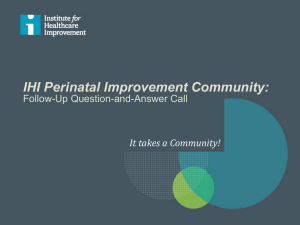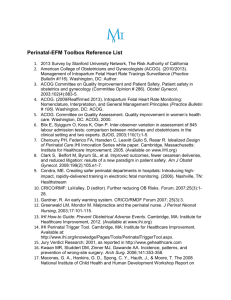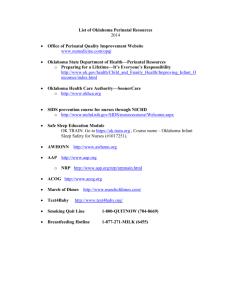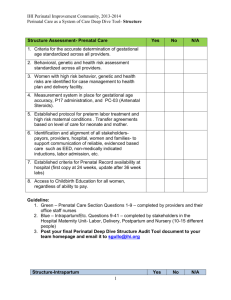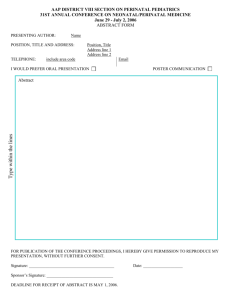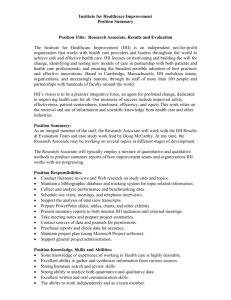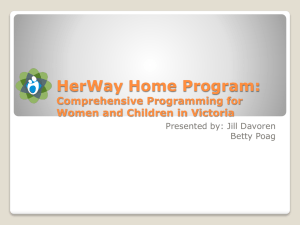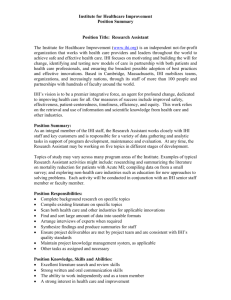Simpson KR, Atterbury J. Trends and Issues in Labor
advertisement
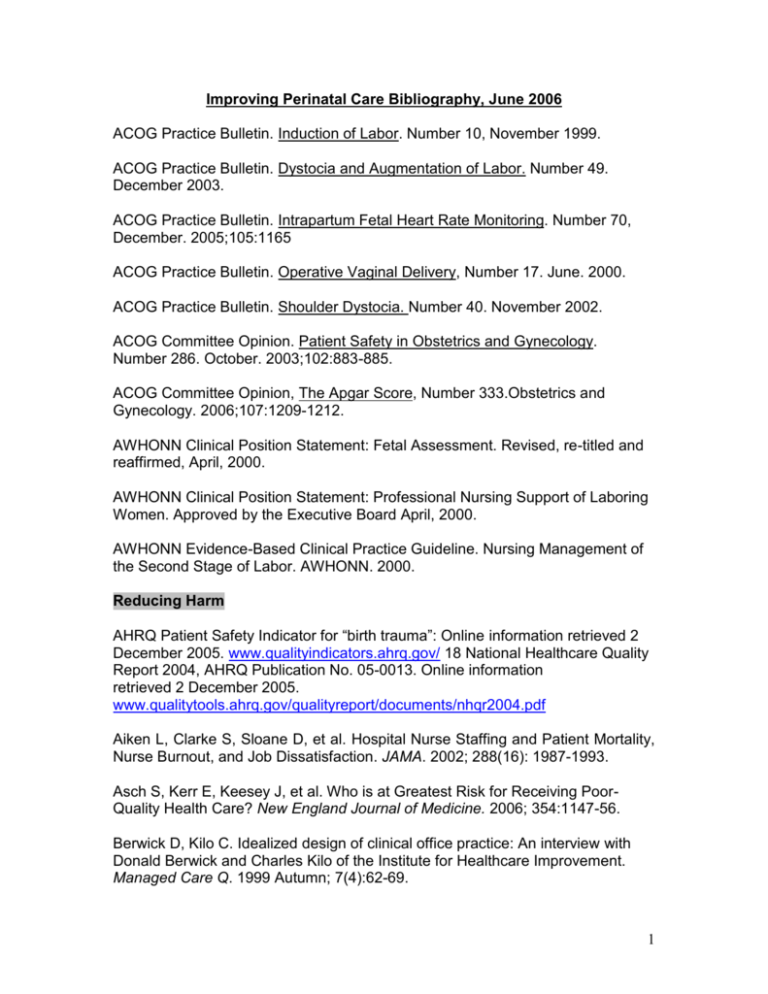
Improving Perinatal Care Bibliography, June 2006 ACOG Practice Bulletin. Induction of Labor. Number 10, November 1999. ACOG Practice Bulletin. Dystocia and Augmentation of Labor. Number 49. December 2003. ACOG Practice Bulletin. Intrapartum Fetal Heart Rate Monitoring. Number 70, December. 2005;105:1165 ACOG Practice Bulletin. Operative Vaginal Delivery, Number 17. June. 2000. ACOG Practice Bulletin. Shoulder Dystocia. Number 40. November 2002. ACOG Committee Opinion. Patient Safety in Obstetrics and Gynecology. Number 286. October. 2003;102:883-885. ACOG Committee Opinion, The Apgar Score, Number 333.Obstetrics and Gynecology. 2006;107:1209-1212. AWHONN Clinical Position Statement: Fetal Assessment. Revised, re-titled and reaffirmed, April, 2000. AWHONN Clinical Position Statement: Professional Nursing Support of Laboring Women. Approved by the Executive Board April, 2000. AWHONN Evidence-Based Clinical Practice Guideline. Nursing Management of the Second Stage of Labor. AWHONN. 2000. Reducing Harm AHRQ Patient Safety Indicator for “birth trauma”: Online information retrieved 2 December 2005. www.qualityindicators.ahrq.gov/ 18 National Healthcare Quality Report 2004, AHRQ Publication No. 05-0013. Online information retrieved 2 December 2005. www.qualitytools.ahrq.gov/qualityreport/documents/nhqr2004.pdf Aiken L, Clarke S, Sloane D, et al. Hospital Nurse Staffing and Patient Mortality, Nurse Burnout, and Job Dissatisfaction. JAMA. 2002; 288(16): 1987-1993. Asch S, Kerr E, Keesey J, et al. Who is at Greatest Risk for Receiving PoorQuality Health Care? New England Journal of Medicine. 2006; 354:1147-56. Berwick D, Kilo C. Idealized design of clinical office practice: An interview with Donald Berwick and Charles Kilo of the Institute for Healthcare Improvement. Managed Care Q. 1999 Autumn; 7(4):62-69. 1 Bundle Up for Safety. Online information retrieved 27 September 2005. www.ihi.org/IHI/Topics/CriticalCare/IntensiveCare/ImprovementStories/BundleUp forSafety.htm Centers of Excellence for Patient Safety Research and Practice, University of Texas. Safety Climate Survey. Online information retrieved 14 September 2005. www.ihi.org/IHI/Topics/PatientSafety/MedicationSystems/Tools/Safety%20Climat e%20Survey%20(IHI%20Tool) Cherouny PH, Federico FA, Haraden C, Leavitt Gullo S, Resar R. Idealized Design of Perinatal Care. IHI Innovation Series white paper. Cambridge, Massachusetts: Institute for Healthcare Improvement; 2005. (Available on www.IHI.org) DeFrances C, Podgornik M. 2004 National Hospital Discharge Survey. Division of Health Care Statistics. Advance Data from Vital and Health Statistics. 2006. Number 371. Improving the Reliability of Health Care. IHI Innovation Series white paper. Boston, MA: Institute for Healthcare Improvement; 2004. Online information retrieved 14 September 2005. www.ihi.org JCAHO. Preventing infant death during delivery. Sentinel Event Alert #30, 2004. Online information retrieved 21 October 2005. www.jcaho.org/about+us/news+letters/sentinel+event+alert/sea_30.htm Johnson J, Figueroa R, Garry D, et al. Immediate Maternal and Neonatal Effects of Forceps and Vacuum-Assisted Deliveries. Obstetrics and Gynecology. 2004; 103:513-8. Low JA, Victory R, Derrick EJ. Predictive value of electronic fetal monitoring for intrapartum fetal asphyxia with metabolic acidosis. Obstetrics and Gynecology. 1999; 93:285-291. Medical Liability Survey Reaffirms More Ob-Gyns Are Quitting Obstetrics. ACOG News Release, 16 July 2004. Online information accessed 6 December 2005. www.acog.org/from_home/publications/press_releases/nr07-16-04.cfm Physician Insurers Association of America. Online information retrieved 14 September 2005. www.thepiaa.org Medical Malpractice: Verdicts, Settlements and Statistical Analysis Updated Edition. Horsham,PA: Jury Verdict Research; 2005:12. 2 Menacker, Fay. Trends in Cesarean Rates for First Births abd Repeat Cesarean Rates for Low-Risk Women: United States 1990-2003. National Vital Statistics Report. Volume 54, Number 4 September 22, 2005. Merrill CT, Elixhauser A. Hospitalization in the United States, 2002. Rockville, MD: Agency for Healthcare Research and Quality. 2005. HCUP Fact Book No. 6. AHRQ Publication No. 05-0056. Miller, Lisa. System Errors in Intrapartum Electronic Fetal Monitoring: A Case Review. Journal of Midwifery and Women’s Health. 2005; 50:507–517. Moen RD. A Guide for Idealized Design. Unpublished paper prepared for the Institute for Healthcare Improvement; 2002. Online information retrieved 13 November 2005. www.ihi.org National Institutes of Health State-of-the-Science Conference Statement. Cesarean Delivery on Maternal Request. March, 2006. Available for download at http://consensus.nih.gov/2006/CesareanStatement_Final053106.pdf Nolan, Thomas W. System Changes to Improve Patient Safety. BMJ. 2000; 320:771-773. Radel SJ, Norman AM, Notaro JC, Horrigan DR. Redesigning clinical office practices to improve performance levels in an individual practice association model HMO. Journal of Healthcare Quality. 2001: 23(2):11-5. Resar R, Pronovost P, Haraden C, Simmonds T, et al. Using a bundle approach to improve ventilator care processes and reduce ventilator-associated pneumonia. Joint Commission Journal on Quality and Patient Safety. 2005; 31(5):243-248 Simpson, Kathleen Rice. Cervical Ripening and Induction and Augmentation of Labor, 2nd Edition. AWHONN. 2002. Simpson, Kathleen Rice. Measuring Perinatal Patient Safety: Review of Current Methods. JOGNN. 35, 432-442. 2006. Simpson K.R., Atterbury J. Trends and Issues in Labor Induction in the United States: Implications for Clinical Practice. JOGNN. 2003; 32: 767-779. Simpson K.R., James D. Efficacy of Intrauterine Resuscitation Techniques in Improving Fetal Oxygen Status During Labor. Obstetrics and Gynecology. 2005; 105: 1362-8. 3 Simpson KR, Knox GE. Common areas of litigation related to care during labor and birth: Recommendations to promote patient safety and decrease risk exposure. Journal of Perinatology and Neonatal Nursing. 2003; 17:110-125. Testing Changes. Online information retrieved 27 September 2005. www.ihi.org/IHI/Topics/Improvement/ImprovementMethods/HowToImprove/testin gchanges.htm © 2005 Institute for Healthcare Improvement. Thorman K, Capitulo K.L., Dubow J, et al. Perinatal Patient Safety from the Perspective of Nurse Executives: A Round Table Discussion. JOGNN, 35: 409416. Vasquez L, Kancir S, Crede W, Schlosser JE. Using Idealized Design to improve access and clinical quality. Online information retrieved 13 November 2005. www.scientificsymposium.org/pdf/2004/Vasquez.pdf White AA, Pichert JW, Bledsoe SH, et al. Cause and effect analysis of closed claims in obstetrics and gynecology. Obstetrics and Gynecology. 2005; 105(5 Pt 1):1031-1038. Zeeman G, Khan-Dawood F, Dawood M.Y. Oxytocin and Its Receptor in Pregnancy and Parturition: Current Concepts and Clinical Implications. Review. 1997;89(5)2: 873-883. Teamwork and Communication Agency for Healthcare Research and Quality. Hospital Survey on Patient Safety Culture (HSOPC). Online information retrieved 2 December 2005. www.ahcpr.gov/qual/hospculture Best practices in obstetrics- guideline, see: Clinical guidelines for the obstetrical services of the CRICO-insured institutions. Online information retrieved 26 September 2005. www.rmf.harvard.edu/reference/guidelines/obguide/obguide_03.pdf CAP 720 Flight Crew Training: Cockpit Resource Management (CRM) and LineOriented Flight Training (LOFT). Downloaded for use at www.caa.uk. Civil Aviation Authority. 2002. August. 4 Clinical Handover and Patient Safety Literature Review Report. Australian Council for Safety and Quality in Health Care. 2005. March. Available at www.safetyandquality.org Fox M, Kilpatrick S, King T, Parer JT. Fetal heart rate monitoring: Interpretation and collaborative management. Journal of Midwifery Women’s Health. 2000; 45:498-507. Helmreich RL. On error management: Lessons from aviation. BMJ. 2000; 320:781-785. Johnson CE, Handberg E, et al. Improving perinatal and neonatal patient safety: The AHRQ Patient Safety Indicators. Journal of Perinatal & Neonatal Nursing. 2005;19(1):15-23. Nemeth C, O’Connor M, Klock A, et al. Cognitive Artifacts’ Implications for Health Care Information Technology: Revealing How Practitioners Create and Share Their Understanding of Daily Work. Advances in Patient Safety: Vol. 2. Makary M, Sexton B, PronovostP, et al. Operating Room Teamwork Among Physicians and Nurses: Teamwork in the Eye of the Beholder. From the Department of Surgery1, John Hopkins University School of Medicine; Department of Health Policy and Management2, Johns Hopkins Bloomberg School of Public Health; and the Johns Hopkins Patient Safety and Quality Research Group3, Johns Hopkins Medical Institutions, Baltimore, MD. October, 2005. http://www.hopkinsmedicine.org/Press_releases/2006/05_01A_06.HTML http://www.npsf.org/congress/posters/Research/Paine,Lori-Abstract2.doc Miller LA. Patient safety and teamwork in perinatal care: Resources for clinicians. Journal of Perinatal & Neonatal Nursing. 2005;19(1):46-51. Patterson E, Woods D, Cook R. Collaborative Cross-Checking to Enhance Resilience. Proceedings of the Human Factors and Ergonomics Society 49 th Annual Meeting. 2005. SBAR Technique for Communication: A Situational Briefing Model. Online information retrieved 14 September 2005. www.ihi.org/IHI/Topics/PatientSafety/SafetyGeneral/Tools/SBAR TechniqueforCommunicationASituationalBriefingModel.htm Simpson KR, Creehan PA. AWHONN, Perinatal Nursing. Philadelphia: Lippincott-Raven; 1996. Simpson KR. Failure to rescue: Implications for evaluating quality of care during labor and birth. Journal of Perinatal & Neonatal Nursing. 2005;19(1):24-34. 5 Simpson KR, Atterbury J. Trends and issues in labor induction in the United States: Implications for clinical practice. JOGNN. 2003;32:767-779. Spear S, Schmidhofer M. Ambiguity and Workarounds as Contributors to Medical Error. Annals of Internal Medicine. 2005;142:627-630. Patient Centeredness Dana-Farber/Brigham and Women’s Cancer Center Adult Patient and Family Advisory Council Bylaws. Dana-Farber and Brigham and Women’s Cancer Center. Gramling L, Hickman K, Bennett S. What Makes a Good Family-Centered Partnership Between Women and Their Practitioners? A Qualitative Study. BIRTH. 2004; 32(1): 43-48. Institute of Medicine. Crossing the Quality Chasm: A New Health System for the 21st Century. 2001. National Academy of Sciences. Institute of Medicine. Keeping Patients Safe: Transforming the Work Environment of Nurses. 2004. National Academy of Sciences. Martell, Louise K. From Innovation to Common Practice: Perinatal Nursing Pre1970 to 2005. Journal of Perinatal and Neonatal Nursing. 2006; 20(1):8-16. Martell, Louise K. Postpartum Women’s Perceptions of the Hospital Environment. JOGNN. 2006; 32(4): 478-485. Tanassi, Lucia M. Compliance as Strategy: the importance of personalized relations in obstetric practice. Social Science and Medicine. 2004; 59: 20532069. Strategies for Leadership: Patient and Family-Centered Care Toolkit. AHA in partnership with the Institute for Family-Centered Care. Available for free download at http://www.aha.org/aha/key_issues/patient_safety/resources/patientcenteredcare .html Disparity “Medicaid’s Role for Women”. Issue Brief: An Update on Women’s Health Policy. November. 2004. The Henri J. Kaiser Foundation. Available for free download at www.kff.org. . 6
